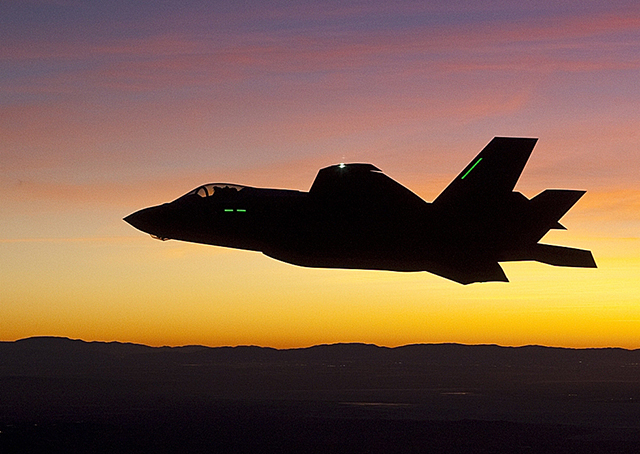After 15 years of political wrangling, setbacks, and successes, an F-35 Lightning II made its civilian airshow debut July 23 at EAA AirVenture in Oshkosh, Wisconsin. The fighter is poised to replace U.S. military workhorses including the A-10, F-16, F/A-18, and AV-8B Harrier jets, and a variety of fighters for at least ten other countries. It even has its own Twitter account and Facebook page.
The fifth generation fighter that is capable of Mach 1.6 shows its agility at the other end of the performance spectrum with short takeoffs and vertical landings. From the cockpit, F-35 pilots sit astride a single-engine, single-seat jet fighter featuring sensor fusion, network-enabled operations, electro-optical targeting systems, and 18,000 pounds of fuel capable of propelling them to a 1,200-nautical-mile range in certain configurations.
Two U.S. Air Force pilots who teamed up to fly a pair of the aircraft 900 miles from Eglin Air Force Base in Florida to Oshkosh, Wisconsin, were confident the Lightning II will advance air superiority into the twenty-second century. (One F-35A was on display, but the other was hidden stealthily nearby if needed.)
During a flight debriefing, Col. Chris Niemi and Maj. Nash Vickers both said a comparison of the radar-absorbing F-35 to its nimble but less stealthy twin-engine F-22 cousin might not reveal the whole story.
Niemi has eight years in the cockpit of an F-22 and is one of the few Air Force pilots who is qualified in both the Raptor and the F-35 Lightning II. He said he wanted to set the record straight on the Lightning II, once and for all. “Many have compared the F-22 to the F-35 but that comparison is unfair. With the F-35 Lightning, this fighter sees better, has more range, and is stealthier than any of its predecessors. This airplane, with its fly by wire technology, is super easy to fly and it has a very linear response.”
By making the airplane easier to fly, Niemi said pilots could better focus on the aircraft’s true mission. Vickers pointed out some of the F-35’s advanced technology including reduced signature jet inlets and nozzles, and fixed array radar enabling the Lightning II to carry air superiority toward the twenty-second century.
“In the F-35, stealth technology has been built in starting with the aircraft’s shaping, the seals, and the big one—the buried [jet engine] inlet. The whole jet is covered in radar deflection material, and six cameras providing 3-D infrared imagery around the cockpit feed into one display for targeting." He added that on the helmet-mounted display, "when pilots move their heads, the information turns with them so they don’t have to be pointed at the target to be effective."
Capt. Hope Cronin, the chief of public affairs, explained how even the helmets that F-35 pilots wear provide a quantum leap forward in fighter technology. "The true merit of the helmet is found in its integrated night vision and High Off-Boresight System," Cronin said. "The helmet streamlines functions within the cockpit and enables the pilot to wield the significant sensor suite available on the F-35 with ease. The ability to activate night-vision or IR imagery with the press of a button, or to target a ground marker with a turn of the head is a major advancement that will return precious seconds and minutes during combat sorties."
The F-35's Rolls-Royce and Pratt & Whitney engine has the same core as an F-22 engine, but has 43,000 pounds of thrust, said Cronin. She added that in its stealth configuration the F-35A carries 5,000 pounds of munitions internally, including a stealth-designed four-barrel 25-millimeter Gatling gun with approximately 180 rounds on board. The F-35B and F-35C variants carry different payloads and do not have an internal gun.
Niemi explained the range advantage that sets the Lightning II apart from previous fighter designs. “One of the things I really like about the F-35 is the amount of fuel we carry, and with 18,000 pounds that is a lot of fuel. F-15s, F-16s, and F-18s don’t have those kinds of legs. The F-35 can get you to places they can’t because of its one engine versus the two engines of the other jet fighters.”
For the quick two hour, ten minute jaunt from Florida to AirVenture, each fighter jet burned about 5,000 pounds of fuel at 270 knots. Niemi said typical approach speeds are 150 knots and strictly by a 13-degree angle of attack all the way to the ground. “It’s a real easy plane to fly and it has good powerful [air] brakes. At 100 knots it will sit down pretty good,” he said.
In a July 31 news release linked from the aircraft’s popular social media site, Gen. Joseph Dunford, Commandant of the Marine Corps, pronounced the jet fully operational and fit to deploy for battle, drawing nearly 20,000 Facebook likes and 2,000 shares.
The Lightning II, with its sleek fuselage, its enormous engine, and its ability to fuse information across a multi-spectrum suite, remained a popular Boeing Plaza photo spot for attendees throughout the EAA AirVenture weekend.

















